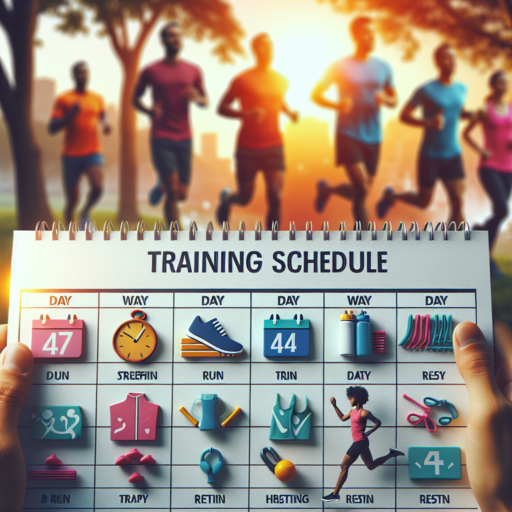Introduction to Training for a Sub 2 Hour Half Marathon
Achieving a sub 2 hour half marathon is a prestigious milestone eagerly sought after by runners worldwide. This goal not only demands dedication and a solid base of endurance but also necessitates a carefully crafted training strategy tailored to enhance speed, stamina, and overall running efficiency. In the realm of distance running, breaking the 2-hour barrier in a half marathon symbolizes a transition from a casual enthusiast to a serious runner. Therefore, understanding the fundamental principles behind effective training is essential for those aspiring to this achievement.
Embarking on a journey toward a sub 2 hour half marathon begins with structured training plans that incorporate a mix of running paces, from easy recovery runs to intense speed sessions. The essence of this training lies in its ability to gradually adapt the body to sustain a pace of 9:09 minutes per mile or faster, which is necessary to finish under the coveted 2-hour mark. Moreover, balanced nutrition, adequate hydration, and proper rest are equally pivotal, forming the backbone of a successful training regimen.
Success in achieving a sub 2 hour half marathon is not solely the product of physical preparation. Mental resilience and strategy also play critical roles. Runners must cultivate a mindset that embraces challenge and resilience, preparing mentally for the rigors of the race ahead. Additionally, strategizing factors like race day nutrition, pacing strategies, and familiarizing oneself with the race course can offer substantial advantages. Such comprehensive training approaches encompass the multi-dimensional aspects of preparing for a sub alle 2-hour half marathon, highlighting the interplay between physical readiness and mental fortitude.
Key Components of a Sub 2 Hour Half Marathon Training Plan
Achieving a sub 2 hour finish in a half marathon is a common goal among many runners, blending the need for speed with endurance. Understanding the key components of a specialized training plan can unlock the potential to not only meet but also exceed this ambitious target. Central to these training plans are tailored workouts, nutrition strategies, and recovery protocols designed to incrementally boost performance.
First and foremost, structured interval training is crucial. This involves alternating between periods of high-intensity running and recovery. Such sessions increase both aerobic capacity and speed, essential for maintaining an average pace close to or below 9:09 per mile, the pace necessary to break two hours. Incorporating long runs to improve endurance is equally important; gradually increasing the distance of these weekly runs enables the body to adapt to the rigors of sustained running over longer periods.
Consistency and variety in training sessions also play a pivotal role. Implementcript, and closing tag.ing a mix of tempature, learning HIIT sessions alongside traditional long runs not only prevents the training from becoming monotonous but also challenges the body to adapt to different types of stress. This approach fosters improvements in running economy and overall fitness, making the sub 2 hour goal more achievable. Nutrition and recovery strategies, including adequate hydration, balanced meals, and proper sleep, complement the physical training by optimizing the body’s repair and endurance capabilities.
Week-by-Week Sub 2 Hour Half Marathon Training Schedule
Embarking on the journey to complete a half marathon in under two hours is an ambitious goal that demands a tailored and disciplined approach to training. Achieving a sub 2-hour finish requires not only physical preparation but also strategic planning and perseverance. Below, we delve into a structured approach that can guide you through the weekly milestones necessary to reach this impressive feat.
Early Weeks: Foundation and Stamina Building
The initial phase of the training schedule is focused on building a solid base of endurance. This period is crucial for preparing your body for the more intense workouts that will come later. During the early weeks, aim to gradually increase your weekly mileage at a comfortable pace, ensuring you incorporate at least one long run into your regimen. This slow build-up aids in enhancing your stamina while minimizing the risk of injury.
Mid-Training: Introducing Speed and Strength Workouts
As you progress into the mid-phases of the training schedule, it’s essential to start incorporating speed and strength training sessions. Intervals and tempo runs become key elements of your weekly plan, aiming to improve your running efficiency and pace. Balancing these more intense workouts with regular rest days and easy runs is critical to allow your body to recover and adapt to the increasing demands.
Late Training: Tapering and Race Strategy
In the final weeks leading up to the race, tapering becomes an integral part of your schedule. Reducing your mileage gradually will help your body to recover from the preceding months of hard training and prepare for race day. Additionally, use this time to develop and refine your race strategy, considering pacing, nutrition, and hydration. Focusing on mental preparation is equally important, as mental resilience will be a key factor in successfully achieving a sub 2-hour half marathon.
Essential Nutrition and Diet Tips for Half Marathon Training
Training for a half marathon requires not just dedication to running, but also paying keen attention to your nutrition and diet. To perform at your best and recover quickly, it’s crucial to fuel your body with the right nutrients at the right times.
Nutrient-Rich Foods Are Your Fuel
When preparing for a half marathon, your body needs a blend of carbs, proteins, and fats. Carbohydrates are significant as they are your body’s primary energy source during long runs. Opting for complex carbohydrates like whole grains, fruits, and vegetables provide a steady energy release. Proteins are essential for muscle repair and recovery post-training. Incorporate lean protein sources such as chicken, fish, beans, and legumes. Healthy fats found in nuts, seeds, and avocados should also be part of your diet to support overall health.
Hydration: A Key Element in Training
Hydration cannot be overstated in its importance during half marathon training. Water regulates your body temperature, lubricates your joints, and aids in transporting nutrients to give you energy and keep you healthy. It’s recommended to stay hydrated throughout the day and adjust your intake based on your training intensity and environmental conditions.
The Role of Timing in Your Nutrition Plan
Strategic timing of your meals and snacks can significantly impact your training effectiveness and recovery. Eating a balanced meal 2-3 hours before running provides the fuel your body needs. Post-run, consume a mix of carbohydrates and proteins within 30 minutes to aid in recovery and muscle repair. Snacking on fruits or protein bars during long training sessions can also help maintain energy levels and improve performance.
Importance of Speed Work and Interval Training
In the realm of fitness and endurance sports, the emphasis on speed work and interval training has gained significant traction. These training methods are not just about running faster; they are crucial for improving overall athletic performance, endurance, and even metabolic efficiency. Understanding why they hold such importance can fundamentally change how one approaches their training regime.
Speed work, or the practice of incorporating short bursts of high-intensity efforts, challenges the body in a unique way. It stimulates fast-twitch muscle fibers, which are critical for sudden, explosive movements. This type of training elevates one’s running economy, allowing athletes to use oxygen more efficiently during prolonged periods of exercise. Moreover, by pushing the body to adapt to the stress of speed work, individuals can significantly increase their lactate threshold, meaning they can sustain higher intensities for longer without succumbing to fatigue.
Similarly, interval training – alternating periods of high and low intensity – plays a pivotal role in enhancing cardiovascular health and muscular endurance. This method not only boosts the heart’s efficiency in pumping blood but also incites substantial calorie burn, contributing to body fat reduction without compromising muscle mass. Interval training is lauded for its versatility and can be tailored to fit the needs of novices and seasoned athletes alike, making it a highly adaptable component of any workout program.
- Improves aerobic and anaerobic fitness.
- Increases speed and endurance.
- Enhances metabolic efficiency.
No se han encontrado productos.
Long Distance Runs: Building Your Endurance
Long distance running is an activity that challenges both the body and mind. The secret to excelling in this domain largely lies in building your endurance. Cultivating the capability to sustain prolonged physical effort is not an overnight achievement; it’s a skill that is honed through consistent practice and smart strategies.
Effective Strategies for Enhancing Endurance
To embark on the journey of increasing your stamina for long distance runs, incorporating a variety of training methods is crucial. Interval training, which alternates between high-intensity bursts and recovery periods, can significantly boost cardiovascular efficiency. In combination with steady-state runs, where you maintain a consistent speed, your body learns to efficiently manage energy reserves, thus enhancing your overall endurance.
In addition to diversifying your training routines, paying attention to your body’s nutritional needs plays an integral role in endurance building. Consuming a balanced diet rich in carbohydrates, proteins, and healthy fats provides the necessary fuel and recovery support your body demands. Furthermore, staying hydrated and ensuring adequate sleep each night are foundational aspects that cannot be overlooked. Together, these practices form a comprehensive approach to gradually building the stamina required for long distance runs.
Listening to Your Body’s Signals
While pushing your limits is part of the process, recognizing the importance of rest and recovery is equally pivotal. Overexertion can lead to injuries and setbacks, undermining your progress. Therefore, tuning into your body’s signals and allowing sufficient time for muscle repair and rejuvenation is essential. This includes incorporating rest days into your training schedule, engaging in cross-training activities, and possibly consulting with a professional for tailored advice to your unique needs and circumstances.
Recovery Strategies and Injury Prevention Tips
Injuries, a common setback for athletes and fitness enthusiasts, can derail progress and lead to prolonged periods of inactivity. However, adopting effective recovery strategies and adhering to injury prevention tips can significantly reduce the risk of injuries and ensure a quicker return to action. This discussion explores some essential methods to enhance recovery and prevent injuries during physical activities.
Implementing Dynamic Warm-ups
Starting your workout with dynamic warm-ups is crucial in preparing your muscles and joints for the stress of exercise. These warm-ups increase blood flow, improve flexibility, and reduce the risk of strains or sprains. Incorporating movements that mimic your workout activity can particularly gear your body for the intensity to come, effectively minimizing injury risk.
Focus on Recovery Techniques
Post-exercise recovery is equally important as the workout itself. Techniques such as foam rolling, stretching, and proper hydration play a pivotal role in repairing and rebuilding muscle tissues. Implementing active recovery days into your regimen, featuring light exercises like walking or yoga, can further aid in muscle restoration and prevent overuse injuries.
Understanding and applying these recovery strategies and injury prevention tips can have a profound impact on your fitness journey. By prioritizing these practices, athletes and fitness enthusiasts can enjoy a healthier, more sustainable, and effective training routine, free from the setbacks of injuries.
Mental Preparation Techniques for a Sub 2 Hour Finish
Breaking the 2-hour mark in any running event is a significant milestone for many athletes. Achieving this requires not only physical readiness but also a robust mental preparation strategy. Understanding and employing the right mental preparation techniques can make the difference between just finishing and finishing strong. In this discussion, we’ll delve into some strategies athletes can adopt to ensure they are mentally poised for a sub 2-hour finish.
Visualization Techniques
One of the most powerful tools in an athlete’s mental preparation kit is visualization. This involves envisioning yourself successfully crossing the finish line within your target time and mentally rehearsing the race. Imagine the course, the crowd, and the feeling of each step. By doing so, you create a mental blueprint of success that can enhance confidence and reduce race-day anxiety. Incorporating visualization into your pre-race routine can condition your mind to stay focused and positive throughout the event.
Positive Self-talk and Affirmations
Negative thoughts and self-doubt can sabotage even the most physically prepared athlete. Implementing positive self-talk and affirmations into your training can counteract these detrimental thoughts. Regularly remind yourself of your training, your strengths, and your ability to achieve a sub 2-hour finish. Phrases like «I am strong,» «I am prepared,» and «I will succeed» can be powerful motivators. Integrating these affirmations into your daily training regimen helps build a resilient mindset, crucial for tackling the physical and mental challenges of race day.
Setting achievable yet challenging goals plays a critical role in mental preparation. Break down your sub 2-hour objective into smaller, manageable segments, such as half-mile or mile splits that are aligned with your target pace. This approach not only makes the goal seem more attainable but also provides continuous motivation and a sense of achievement throughout the race. Tracking your progress against these mini-goals helps maintain focus and drive, preventing mental fatigue and enhancing performance. Remember, a successful race is not just about the physical effort but equally about strategizing and mental fortitude.
Equipment and Gear Recommendations for Efficient Training
When it comes to enhancing your training regime, selecting the right equipment and gear is paramount. The market is flooded with countless options, making it tricky to distinguish between essential purchases and unnecessary luxuries. Identifying gear that complements your training objectives can significantly elevate your performance and ensure you get the most out of every workout session.
Treadmills and Adjustable Dumbbells stand at the forefront of essential training equipment for home gyms. Treadmills offer a convenient and straightforward way to incorporate cardiovascular exercises into your routine, regardless of outdoor weather conditions. Meanwhile, adjustable dumbbells provide a space-saving solution while enabling a wide range of weightlifting exercises, making them ideal for strength training and muscle building at any fitness level.
Choosing the Right Training Apparel
Equally crucial to the training equipment you select is the apparel you choose to wear during workouts. High-quality, functional training apparel can make a significant difference in your comfort and performance levels. Moisture-wicking fabrics help in regulating your body temperature by drawing sweat away from your body, keeping you dry and comfortable during intense sessions. Additionally, opting for apparel that offers flexibility and supports your body can enhance your mobility and efficiency in performing various exercises.
Success Stories: Runners Who Achieved the Sub 2 Hour Goal
The quest to break the sub 2-hour marathon barrier has captivated the running world for years, creating a special niche of triumphs within long-distance running. The sub 2-hour goal is more than just a number; it represents the pinnacle of endurance, speed, and human potential. Here, we delve into the remarkable journeys of athletes who have etched their names into this elite category, transforming the dream into reality.
The first monumental success story in this realm is Eliud Kipchoge’s historical achievement in Vienna in 2019. Under the Ineos 1:59 Challenge, Kipchoge shattered expectations and the seemingly insurmountable two-hour barrier by clocking in at 1:59:40. This staggering performance wasn’t just a testament to Kipchoge’s unparalleled speed and stamina, but it also symbolized the culmination of cutting-edge training, nutrition, pacing strategies, and even the innovation in running shoes. Kipchoge’s success has set a towering benchmark for future generations and galvanized interest in the limits of human athletic performance.
While Kipchoge’s Vienna run holds a special place in history, it’s crucial to recognize that it was classified as an assisted run due to the use of pace setters and other aids. Therefore, it hasn’t officially broken the marathon world record. Nonetheless, this achievement has spurred other elite runners to chase after this elusive goal under race conditions, igniting a fierce but friendly rivalry that pushes the boundaries of what’s considered possible.
The impact of achieving the sub 2-hour marathon goal transcends individual achievement. It’s reshaped training methodologies, with a greater emphasis on technology and innovation. Athletes and coaches are now more focused than ever on fine-tuning every aspect of preparation, from biomechanics and nutrition to psychological training. The narrative surrounding these success stories isn’t just about the records; it’s about the relentless pursuit of excellence and the indomitable human spirit.



